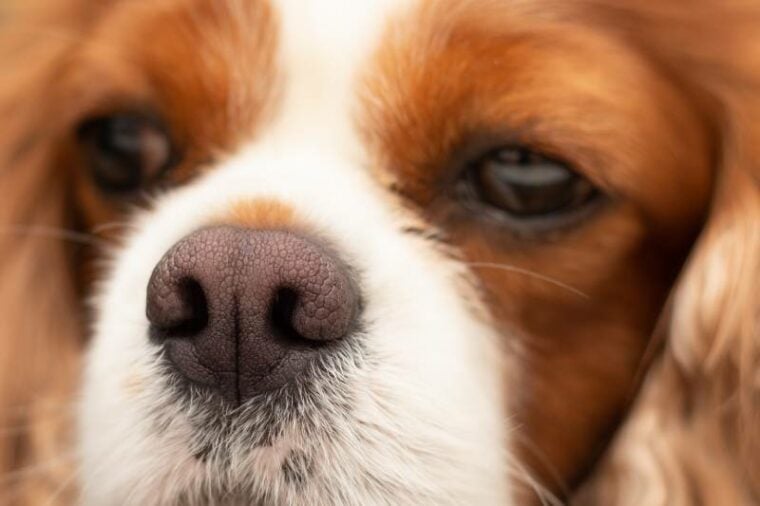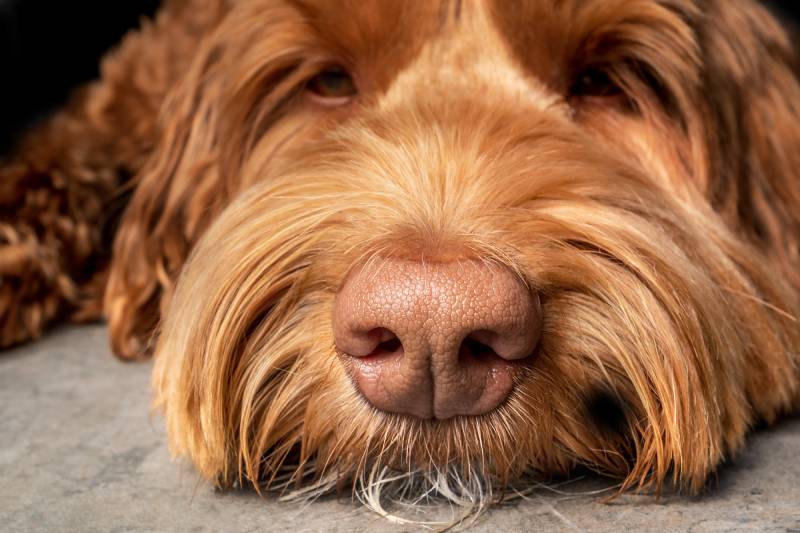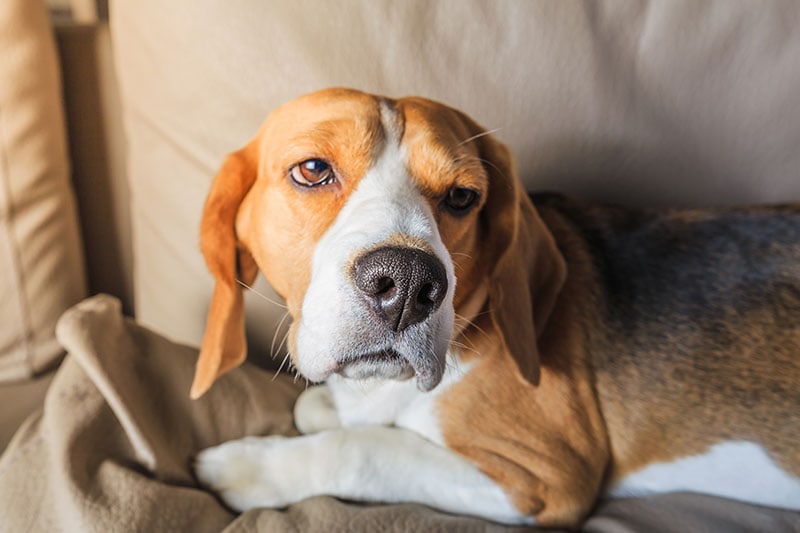
Healthy dogs normally have a moist, cold nose (snout/truffle). However, dogs’ noses can become dry and warm for various reasons that don’t involve your pet being sick, such as being outside in cold or hot weather.
If your dog’s nose is dry, you should remember that even healthy dogs can have a dry nose sometimes, and a sick pet will show other clinical signs besides a dry and/or warm nose.
In this article, you will learn why dogs have dry noses and when dry noses are a cause for concern.
Why Is My Dog’s Nose Dry?
A dog’s nose performs several important functions. It has a sensory role and helps pets capture scents from the environment. Their nose helps them orient themselves in the environment and sense the presence of people, food, pets, danger, or pheromones of other dogs that have marked their territory or of females in heat. In other words, a dog’s snout works like a radar.
The reasons that dogs can have a dry nose are multiple and include the following.
The 8 Reasons Why Your Dog’s Nose Is Dry
1. Walking Your Dog in Cold and Dry Weather
In this case, the temperatures and the wind may dry out your dog’s nose. If the weather is extreme, it can even cause the occurrence of skin lesions, crusts or frostbite if the dog is outside for prolonged periods without a shelter. If the weather is wet due to rain or snow, their nose will be wet.

2. Walking Your Dog in Warm Weather
The warm air may dry out your dog’s nose, but this is temporary, and the nose should regain its moisture when the dog is back inside and drinks water. Dogs can also suffer from sunburn or heat stroke during the summer.1 A sunburned dog’s nose will also appear dry, and may be reddened, inflamed and crusty. Therefore, avoid taking your dog out for long periods when the temperature exceeds 75°F, particularly during the hottest part of the day.
Never exercise or walk your dog at these times, but find indoor games and entertainment instead. Dogs can experience heatstroke even if the outside temperature is not that high or if they are left in a closed car without open windows or air conditioning.
3. Dehydration
Dogs can get dehydrated for many reasons, such as experiencing fluid loss through a stomach upset with vomiting or diarrhea, not eating, having a fever, and more. Strenuous exercise also causes fluid loss and gives your dog a temporarily dry nose.
To see if your dog is dehydrated, your vet will perform the skinfold test by gently grabbing the skin between the shoulder blades and pulling it upward in one direction. The skin should return to its original position straight away. If the skin does not return to its initial position, it means they are dehydrated. However, even dogs with a normal skinfold test can be dehydrated, and that’s why it’s important your dog is assessed by the vet.
Other clinical signs of dehydration will include lethargy, tacky gums, and, in severe cases, sunken eyes. There are other ways for your vet to establish your pooch’s hydration status, and it’s crucial to get them checked out as soon as possible.

4. The Environment in Which Your Dog Lives
If your dog is sensitive to the allergens in the environment (pollen, dust, mites, or mold), they may have a dry nose, although this is not that common or noticeable. If you think your dog is allergic to a certain food protein or environmental allergens, they will show more obvious clinical signs, such as itchy skin, excessive licking and scratching, self-inflicted skin sores, or frequent ear infections, or possibly even gastrointestinal signs, such as diarrhea or vomiting, for all of which they should see the vet.
6. After Sleeping
Most of the time, dogs are tired after long walks or intense play and will sleep more to regain their energy. When dogs sleep more, their noses can get dry overnight, especially if it’s cold or they sleep near a heater.

7. Various Medical Conditions
When dogs suffer from certain medical problems, their noses can become dry. This can happen due to fever, dehydration, hyperkeratosis of the nose, or less commonly, autoimmune and endocrine diseases.
To measure your dog’s temperature to make sure they do not have a fever, you must use a thermometer, but only if your dog will tolerate it and you feel comfortable doing it. Putting your hand on the dog’s nose or ears is not a correct method.
The thermometer will be gently inserted into your dog’s rectum. For this operation, you should use a baby thermometer because it has a flexible tip.
If your dog’s temperature is higher than 102.2°F (39°C), it means they have a fever, and you should contact your veterinarian.
Do not measure your dog’s temperature immediately after they have been walking, playing, or doing any physical effort. Measure it at least 15 minutes after any activity to ensure that it is accurate.
8. Some Dogs Have Dry Noses
Some dogs will just have dry noses. This can be individual, although some brachycephalic breeds may also have more of a dry or even crusty looking noses. This can be due to their increased respiratory efforts, which may dry the nose due to excessive and more forced airflow with frequent panting, or because they cannot reach their nose in order to lick it.
Crusty, dry noses can also be a consequence of hyperkeratosis. This is a common condition, particularly in older dogs, due to excessive production of keratin, which affects the nose and paw pads alike, causing them to appear dry and cracked. If your dog’s nose is suddenly dry, it’s worth getting it checked by the vet, particularly if there are any skin lesions, crusts, scabs, lumps, or other changes on it indicating an underlying health issue.
Is a Dry Nose a Cause for Concern?
If your dog plays, eats, is active, and defecates and urinates regularly and without difficulty but has an occasionally dry nose, there is usually no need to worry.
A dry and/or warm nose can be cause for concern if your dog also shows other clinical signs, such as:
All these clinical signs indicate that your dog has an underlying health issue. As a result, you must take them to the vet for a correct diagnosis and appropriate treatment.

What to Do When Your Dog Has a Dry Nose
Conclusion
In most cases, a dog simply having a dry nose does not mean they’re sick. That said, if your dog shows other clinical signs, such as a fever, vomiting, diarrhea, or lack of appetite, all which can lead to dehydration, take them to the vet as soon as possible.
In healthy dogs, a dry nose can occur for several reasons: It is windy and dry, too cold or too hot outside, or they’ve just been asleep. Also, the environment in which your dog lives can favor the occurrence of a dry nose. To make sure your dog’s nose stays moist, use pet-safe moisturizing creams in the winter and sunscreen in the summer. Also, don’t forget to encourage your beloved pet to drink more water when it is hot outside, and always avoid them exercising in such weather.
Featured Image Credit: tativophotos, Shutterstock








